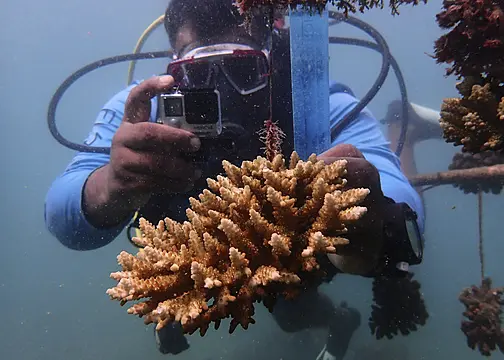Minutes away from the Kenyan mainland, the densely forested island of Wasini is one of several starting lines for coral reef restoration efforts in the western Indian Ocean.
On a rare calm day during the normally turbulent monsoon season, four divers, carrying measuring equipment, shoes and toothbrushes, descended in turn to the seabed reef restoration site in the Shimoni channel.
“We use coral fragments collected from wild populations to establish the nurseries,” said diver Yatin Patel, before slipping into the turquoise waters. “After growing, they’re taken to the coral garden.”

Mr Patel and his team, who are part of the REEFolution foundation, clean the coral nurseries and measure the sizes of the growing corals, which are supported by plastic pipes and pyramid structured steel nets.
The marine area, jointly managed by the foundation and the island’s community, has been planting more than 8,000 corals a year since 2012 and placed about 800 artificial reef structures in the channel in a bid to restore Wasini’s coral gardens.
But the project is threatened by growing costs and a planned fishing port in Shimoni, two miles away on Kenya’s coast.
The United Nation’s Ocean Conference in Lisbon is putting protection and restoration efforts for coral reefs back on the agenda.

The threat of waning fish populations due to dying corals adds to the woes of east African communities, where millions of people are already facing a worsening food crisis because of a prolonged drought in the east and Horn of Africa, as well as ripple effects from the war in Ukraine.
In early March, the Intergovernmental Panel on Climate Change issued a dire warning on the threats faced by African coastal and island nations and a complete collapse of corals in the western Indian Ocean.
The Wasini Island coral initiative is one among many dotted across the Africa’s western shores, after a series of severe coral bleaching bouts due to warming ocean waters.
After a particularly devastating year in 1998, due in large part to the natural weather phenomenon El Nino, huge stretches of the Indian Ocean’s corals — from Somalia to South Africa — were badly affected.

Coral bleaching occurs when extreme temperatures and sun glare simultaneously trigger corals to flush out algae, causing them to turn white. Corals can survive bleaching events, but are under greater stress and cannot effectively support marine life, threatening the populations that depend on them.
Tim McClanahan, a senior conservation zoologist at the Wildlife Conservation Society, said 1998 was not the first such event — there was one in 1983, and since then there have been three in the past two decades, in 2005, 2010 and 2016.
The prevalence of mass coral bleaching along the western Indian Ocean has worried scientists for decades and intensive studies to understand and map out interventions to curb the phenomena are continuing. Many of these bleaching events are directly linked to climate change, Mr McClanahan said.
The Wasini coral restoration project followed in the footsteps of Nature Seychelles, a conservation non-governmental organisation in the Seychelles archipelago which initiated the western Indian Ocean’s first coral replanting exercise in the same year and is continuing more than a decade later. A similar project was undertaken in Tanzania.







